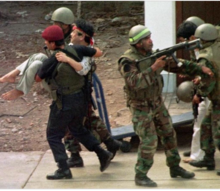This article's lead section contains information that is not included elsewhere in the article. (July 2021) |
| Japanese embassy hostage crisis | |
|---|---|
| Part of the internal conflict in Peru | |
 Peruvian forces rescuing Japanese diplomats
| |
| Location |
|
| Coordinates | 12°05′29″S 77°02′58″W / 12.09139°S 77.04944°W |
| Date | 17 December 1996 – 22 April 1997 |
| Target | Japanese embassy residence in Peru |
Attack type | Hostage-taking |
| Deaths | 17 (1 hostage, 2 soldiers, 14 MRTA militants) |
| Injured | 8 |
| Perpetrators | Túpac Amaru Revolutionary Movement (MRTA) |
The Japanese embassy hostage crisis (Spanish: Toma de la residencia del embajador de Japón en Lima, Japanese: 在ペルー日本大使公邸占拠事件, romanized: Zai Perū Nihon taishi kōtei senkyo jiken) began on 17 December 1996 in Lima, Peru, when 14 terrorist members of the Túpac Amaru Revolutionary Movement (MRTA) took hostage hundreds of high-level diplomats, government and military officials and business executives. They were attending a party at the official residence of the Japanese ambassador to Peru, Morihisa Aoki, in celebration of Emperor Akihito's 63rd birthday. Although the crisis took place at the ambassadorial residence in San Isidro rather than at the embassy proper, it is often referred to as the "Japanese embassy" hostage crisis.
Foreign female hostages were released during the first night and most foreigners left after five days of constant death threats. After being held hostage for 126 days, the remaining dignitaries were freed on 22 April 1997, in a raid by Peruvian Armed Forces commandos, during which one hostage, two commandos, and all the MRTA militants were killed. The operation was perceived by most Peruvians to be a great success, and it gained worldwide media attention. President Alberto Fujimori initially received much credit for saving the lives of the hostages.
Reports later emerged alleging that a number of the insurgents were summarily executed after surrendering. Japanese diplomat Hidetaka Ogura testified that three of the rebels were tortured. Two of the commandos maintained that they saw Eduardo "Tito" Cruz alive and in custody before he was found with a bullet wound in his neck. These findings prompted civil suits against military officers by the relatives of dead militants. In 2005, the Attorney General's office in Peru allowed the charges and hearings were ordered.[1] After public outcry, all charges were dropped; however, further investigations were referred to the Inter-American Court of Human Rights.[2][3] It ruled in 2015 that Cruz had been the victim of an extrajudicial killing and that the Peruvian government violated international law. The court also named 25-year-old Victor Peceros and 17-year-old Herma Meléndez as victims deprived of their human rights.[4]
- ^ "Peru state attorney seeks Fujimori murder charges" (9 March 2001) CNN, Retrieved 10 April 2007
- ^ "Peru's famed hostage raid investigated" (3 January 2012) AP Big Story [dead link]
- ^ Briceno, Franklin (18 May 2012). "Peru's famed hostage raid investigated". Deseret News. Associated Press. Archived from the original on 12 July 2018. Retrieved 12 July 2018.
- ^ Post, Colin (29 June 2015). "IACHR: Peru violated executed rebel's human rights". Peru Reports. Peru Reports/Colombia Reports. Retrieved 12 July 2018.